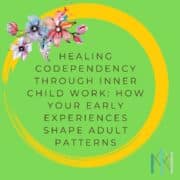
Many adults struggling with codependency find themselves over-functioning in relationships, prioritizing others’ needs over their own, and struggling with low self-worth. They often feel an intense responsibility to keep others happy while neglecting their own emotional needs. While these behaviors may seem like personality traits or habits, they are often rooted in early childhood experiences—specifically in unmet emotional needs, family dynamics, or attachment wounds that shaped how they relate to others.
Inner child work is a therapeutic approach that helps individuals reconnect with the younger parts of themselves that learned self-sacrifice, over-responsibility, and fear of abandonment as survival mechanisms. By understanding and healing the wounds of their inner child, individuals can begin to release the unconscious patterns that keep them stuck in codependent relationships and build a stronger sense of self-worth, autonomy, and emotional balance.
Learn more about codependency

How Childhood Experiences Shape Codependent Patterns
Codependency is not something you are born with—it is a learned relational strategy that develops in response to your early environment. Many codependent behaviors originate from childhood experiences where emotional needs were not consistently met, or where love and approval were conditional.
1. Growing Up in an Emotionally Neglectful or Chaotic Home
Children who grow up in emotionally unstable or neglectful homes often learn to prioritize others’ emotions over their own as a way to maintain connection. If a parent was emotionally unavailable, erratic, or struggling with their own issues, the child subconsciously takes on the role of caretaker, peacemaker, or emotional support system. Over time, this develops into codependency—where pleasing others becomes a survival mechanism for maintaining relationships.
2. Learning That Love Must Be “Earned”
If a child only received attention, praise, or affection when they were helpful, high-achieving, or emotionally accommodating, they may develop the belief that their worth is based on what they can do for others rather than who they are. This can lead to a lifelong pattern of over-giving, people-pleasing, and self-sacrifice in relationships.
3. Experiencing Inconsistent or Conditional Affection
When a child grows up in an environment where love and approval are inconsistent—where one day they are praised and the next day ignored or criticized—they may develop anxious attachment patterns. This unpredictability leads to fear of abandonment, hyper-vigilance in relationships, and a tendency to overcompensate to maintain connection. This cycle is often replicated in adulthood, where individuals stay in unhealthy relationships out of fear of being alone.
4. Witnessing Codependent Dynamics in Caregivers
Children often model what they see in their primary caregivers. If a parent was over-functioning in relationships, self-sacrificing, or constantly seeking validation from others, the child may internalize these behaviors as the normal way to relate to others. Without realizing it, they may repeat these same patterns in their own friendships, romantic relationships, or work environments.
5. Being Parentified at a Young Age
Some children are placed in adult-like roles where they must take on responsibilities beyond their developmental capacity. This could include:
- Being the emotional confidant for a parent
- Taking care of younger siblings when caregivers were absent
- Managing household duties that should have been the responsibility of adults
When a child is forced to be “the responsible one”, they learn to dismiss their own needs and focus on the well-being of others. This often carries into adulthood, where they feel an obligation to “fix” or take care of others, even at the expense of their own well-being.
What Is Inner Child Work and How Does It Help Codependency?
Inner child work is a therapeutic process that helps individuals reconnect with the younger parts of themselves that learned these unhealthy survival strategies. The goal is to:
- Identify the core emotional wounds that drive codependent behaviors
- Reparent the inner child by offering the validation, safety, and care that was lacking in childhood
- Develop healthy self-worth independent of how much one gives to others
By healing these early wounds, individuals can reprogram their beliefs about self-worth, relationships, and emotional security, breaking free from codependent cycles.
How Inner Child Work Helps Shift Codependent Patterns
Recognizing Where the Patterns Began – Many people assume their codependent tendencies are simply “who they are.” Inner child work helps identify where these patterns were first learned, providing the self-awareness needed to create change.
Developing Self-Compassion Instead of Self-Judgment – Many codependent individuals struggle with self-criticism and guilt when trying to set boundaries or prioritize themselves. Inner child work encourages self-compassion, recognizing that these behaviors developed as a survival strategy, not a personal flaw.
Rewriting Core Beliefs About Love and Worthiness – By healing the inner child, individuals learn that:
-
- Love does not have to be earned through over-giving
- Setting boundaries does not make them unlovable
- Their needs are just as valid as others’ needs
This internal shift allows for healthier, more balanced relationships.
Learning to Meet Emotional Needs Without Over-Reliance on Others
Instead of seeking validation or security from relationships, inner child work teaches individuals how to self-soothe, self-validate, and care for their own emotional needs. This helps break the cycle of emotional dependence on others for happiness.
Practical Steps to Begin Healing Your Inner Child
If you recognize these patterns in yourself, inner child work can help break free from codependency and build a healthier, more self-sufficient emotional foundation. Here are some steps to begin:
1. Identify Your Inner Child’s Needs
Ask yourself:
- What emotional needs were not consistently met in childhood?
- When did I first learn that my worth was based on what I do for others?
- What would I say to my younger self if I could reassure them today?
2. Reconnect with Your Inner Child
Engage in practices that help create a relationship with your inner child, such as:
- Writing a letter to your younger self, offering validation and reassurance
- Visualizing yourself as a child and imagining giving them the comfort and security they lacked
- Reflecting on childhood memories that shaped your beliefs about relationships
3. Practice Self-Parenting
As you reconnect with your inner child, practice self-parenting by providing the love, care, and encouragement you may have missed growing up. This includes:
- Setting boundaries to protect your emotional well-being
- Speaking to yourself with kindness and self-compassion
- Prioritizing rest, self-care, and activities that bring you joy
4. Seek Therapy for Deeper Healing
Inner child wounds are often deeply rooted and may require professional support. Therapy can help:
- Uncover unconscious beliefs driving codependency
- Develop strategies to break codependent patterns
- Provide a safe space to process unresolved childhood pain
How Inner Child Work Fits into Established Therapeutic Approaches
Inner child work is not a separate, standalone therapy—instead, it is a concept and set of practices that can be integrated into multiple therapeutic modalities. If you struggle with codependency, relational anxiety, or unresolved childhood wounds, working with a therapist trained in parts work, attachment healing, and trauma processing can help you:
- Understand why you default to people-pleasing and over-functioning in relationships
- Recognize the inner child’s role in maintaining these patterns
- Develop self-compassion and emotional self-sufficiency
- Break free from cycles of self-sacrifice, guilt, and over-responsibility
1. Gestalt Therapy: Dialoguing with the Inner Child
Gestalt therapy, developed by Fritz Perls, encourages clients to explore different parts of themselves through techniques like the empty chair exercise, where individuals can directly communicate with their inner child. This process helps bring unconscious emotions and unmet needs into conscious awareness, allowing the client to provide the support and validation they may have lacked as a child.
Gestalt therapy also focuses on present-moment awareness, helping individuals recognize when old childhood patterns are playing out in current relationships. For example, someone with a deep fear of abandonment might react strongly to minor relationship conflicts, not realizing that their inner child is reliving past rejection experiences.
2. Internal Family Systems (IFS) and Parts Work
Internal Family Systems (IFS), developed by Richard Schwartz, is a structured form of parts work therapy that views the psyche as a system of different sub-personalities, or “parts.” In this model, the inner child is often seen as a wounded, vulnerable part that carries deep emotional pain from early life experiences.
IFS helps individuals:
- Identify the inner child and other parts (such as the “caretaker,” “people-pleaser,” or “protector” that emerged to cope with childhood distress)
- Build a relationship with these parts through self-compassion and understanding
- Reintegrate the inner child into a healthier, more balanced self-system
For codependent individuals, IFS can be particularly effective in identifying the protector parts that enforce people-pleasing and self-sacrifice as defense mechanisms. Therapy helps these parts release their burden, allowing for healthier boundaries and emotional self-reliance.
3. Schema Therapy: Rewriting Deep-Rooted Childhood Patterns
Schema therapy, developed by Jeffrey Young, integrates elements of CBT, psychodynamic theory, and attachment-based approaches. It identifies maladaptive schemas (deep-rooted belief systems formed in childhood) and helps individuals recognize how these early experiences drive dysfunctional relationship patterns in adulthood.
Common schemas found in codependent individuals include:
- Self-Sacrifice Schema – The belief that one must always prioritize others’ needs over their own
- Abandonment Schema – The fear that any conflict or boundary-setting will lead to rejection
- Emotional Deprivation Schema – A deep-seated belief that one’s emotional needs will never truly be met
Schema therapy uses imagery, role-playing, and inner child dialogues to help individuals reprocess childhood experiences and develop healthier beliefs about relationships, self-worth, and personal autonomy.
4. Somatic Therapy: Healing the Inner Child Through the Body
Many inner child wounds are not just psychological but also physiological, meaning they are stored in the nervous system. Somatic therapy helps individuals access and release childhood trauma through body-based techniques, such as:
- Breathwork to soothe stored childhood anxiety
- Movement therapy to release suppressed emotions
- Grounding exercises to create a sense of present-moment safety
For those with codependent tendencies, somatic therapy is particularly helpful in reducing the body’s conditioned stress response to setting boundaries, saying no, or prioritizing oneself—actions that may have felt unsafe in childhood.
5. EMDR for Reprocessing Inner Child Wounds
EMDR (Eye Movement Desensitization and Reprocessing) is typically used for trauma recovery, but it is also highly effective in addressing childhood wounds that contribute to codependency. EMDR allows individuals to:
- Revisit early experiences of emotional neglect, enmeshment, or abandonment
- Reprocess painful memories so they no longer trigger codependent behaviors in the present
- Install new, healthier self-beliefs that replace old narratives about worth and relationships
For example, if someone was shamed as a child for asserting their needs, EMDR can help rewire the emotional response so that setting boundaries no longer triggers guilt or fear.
If you’re ready to begin inner child healing as part of your codependency recovery, finding a therapist trained in Gestalt therapy, IFS, Schema Therapy, or somatic healing can provide a structured and effective path forward. Our therapists can help!
Browse our Therapist Directory
You Might Also Like to Read:
- Codependency and Perfectionism: Why You Feel Responsible for Everyone Else’s Happiness
- Is It Codependency or Trauma Bonding? How to Tell the Difference
- The Pressure to Be ‘Self-Sufficient’: When Hyper-Independence Masks Codependency
- FAQ About San Francisco Codependency Therapy
- Codependency in Multiple Partner Relationships



